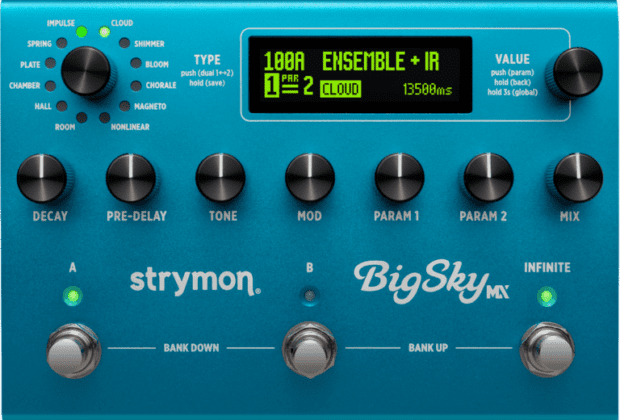It is safe to say that most guitarists have owned, own, or at least are aware of Strymon reverb pedals, with the iconic blueSky and BigSky reverb units having found their way onto countless boards the world over.
Strymon recently released BigSky MX, a truly next generation reverb workstation. Not just an update and almost four years in development, Strymon’s BigSky MX is a “back-to-the-drawing-board” recreation of virtually every algorithm from the original BigSky. In designing BigSky MX, each reverb algorithm was run through what Strymon calls a gradient descent optimization process, which is a machine-learning procedure that helps to identify and remove any undesirable ringing or artifacts in the reverbs. The sound quality of BigSky MX is a major step up from the original as a result.
The brand-new OLED display shows you a bunch more information than the small screen on the original BigSky, from parameters and visual values to which of the two reverb engines you are currently editing. The brightness is adjustable, and easy to see in all lighting conditions. From the front panel of BigSky MX are seven knobs that give you access to the most used parameters: decay, pre-delay, tone, modulation, two assignable parameters, and your overall dry and wet mix.
BigSky MX is powered by an advanced 800MHz tri-core ARM processor which is, as far as I know, the most powerful processor ever put into a stand-alone reverb pedal, and is many times more powerful than the SHARK processors found in the previous generation BigSky and blueSky reverb pedals. The Tri-Core ARM processor also fundamentally provides enhanced dynamic response for the reverb’s algorithms. BigSky MX really tracks along with your playing well, allowing you a degree of self-expression and nuances in your playing that is immediately noticeable.
With BigSky MX, you can have two completely independent reverb engines (or “machines” as Strymon calls them) running simultaneously. You can access both the engines, as well as their individual parameters, simply by clicking on the Type select knob.
There are a couple of ways you can set that up. For example, if you scroll to the first reverb you can run that in parallel, so that the two reverb engines are running side-by-side meaning the same signal will feed into both simultaneously, mixed, and then go to the outputs. Press the Type encoder again and you can run your signal path in series. In that case, reverb engine one is going to feed into reverb engine two. Press Type again, and you can reverse that signal order. Press one more time, and you are splitting left and right with the two engines. You can also reverse that and go right to left.
The Global menu allows you to adjust your input levels, MIDI channel, MIDI controllers, program changes, the foot switch banks, active banks and more. Pressing and holding the Value encoder for three seconds will get you into the Global settings, and from there you can choose between true or buffered bypass operation. Most of the global settings can be adjusted either on a preset level or global level, which allows you to tailor how you want to use BigSky MX. MX also has filtering, and both algorithmic and IR-based speaker cab emulation built in.
One of the new reverb machines inside BigSky MX is the Impulse machine, which loads up to 10-second long stereo impulse responses into a convolution engine. BigSky MX comes pre-loaded with 22 impulse responses, including emulations of many classic studio processors and some amazing outboard spring reverbs. You can edit the impulse response right on BigSky MX, so you can easily resample the IR and stretch or shrink it to change the length, reverse it or add envelopes. You can even change the modulation, add modulation or adjust the tone of the impulses—it’s a very powerful set of features that has the potential to unlock a host of new sounds.
The Shimmer machine now has two different modes. You can operate in a fast, modern mode or you can switch over and use Classic mode like you had in the previous generation BigSky. The Bloom machine has a new Harmonics engine allowing you to add an extended set of harmonic content to add depth. With the Chorale machine, you can add a tenor or a baritone, of course, to your guitar signal. The Spring machine now has two versions, the new updated version and the Classic version that came from the original BigSky. The Nonlinear machine also has a new Chop function that can be used to add tremolo-esque movement to the ambience.
BigSky MX uses what Strymon calls Analog Dry Through. This means that the dry signal coming from your guitar has zero latency and passes straight through to the output without being converted to digital, for the ultimate in analog sound quality. BigSky MX also has a spillover function, which allows the previously selected reverb algorithm to trail off naturally when you switch to a different preset. This is great, as it means that the tail of the current reverb isn’t cut off when you move from preset to preset.
Use the free downloadable Nixie 2 software to manage presets and perform editing of your BigSky MX right from your computer, which connects to MX via the onboard USB-C port. Having the ability to connect via USB is a big improvement over the previous generation BigSky, which required a conventional MIDI interface to connect to your computer. Most of the performance-centric parameters inside BigSky MX can be controlled via MIDI, which MX can communicate with from three different onboard interfaces: USB-C, traditional 5-pin DIN MIDI and the Expression/TRS MIDI jack. The Nixie 2 software also allows you to load your own impulse responses, as well as performing firmware updates.
Strymon’s BigSky MX is a truly next-generation reverb workstation that is, as far as I can see, the most technologically advanced standalone reverb pedal ever created. All of this technological excellence does not come cheap, and some may feel that the cost is on the high side. That said, Strymon is continuing to market the more affordable original BigSky, and they refreshed the original blueSky pedal to the V2 version 18 months ago.
There are obviously great deals to be had on the used market, but if you count blueSky V2, Cloudburst, Flint V2, El Capitan V2, Volante and NightSky, Strymon makes a number of different types of reverbs that can fit any size or budget. To sum it up, not every player (or studio owner) needs the level of sophistication that BigSky MX offers, but if you do, it’s well worth the investment.
The Strymon BigSky MX is available now for MAP $679.
Find out more at strymon.net/product/bigsky-mx













